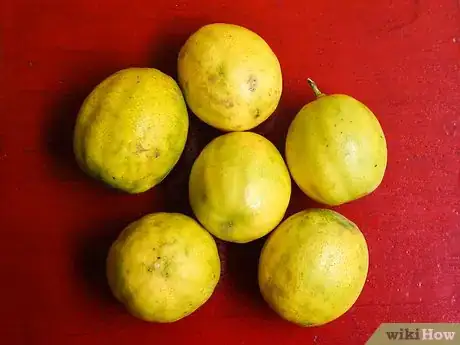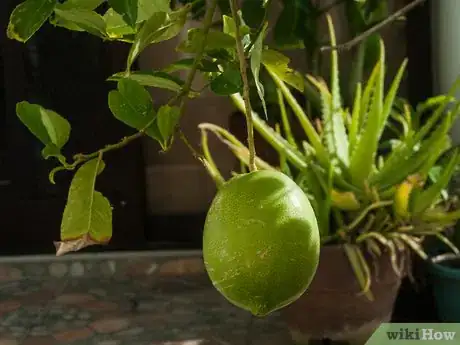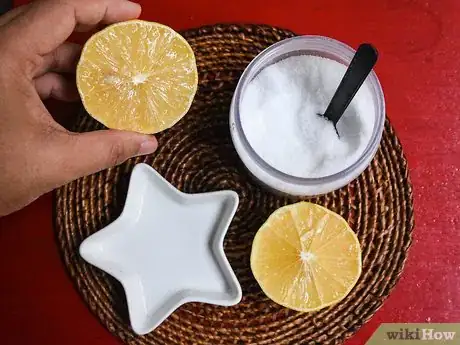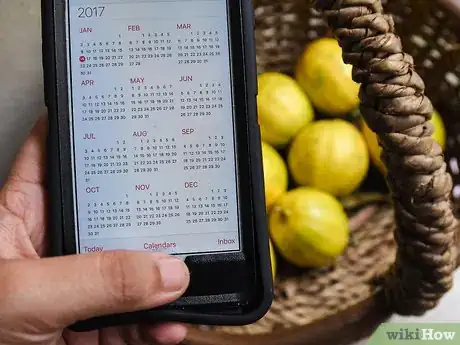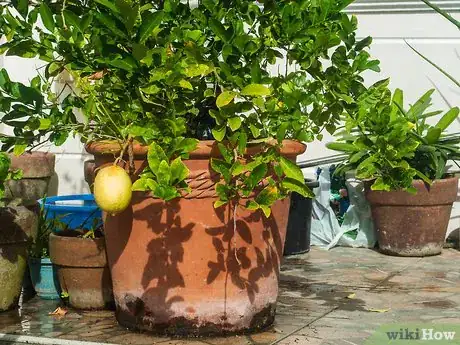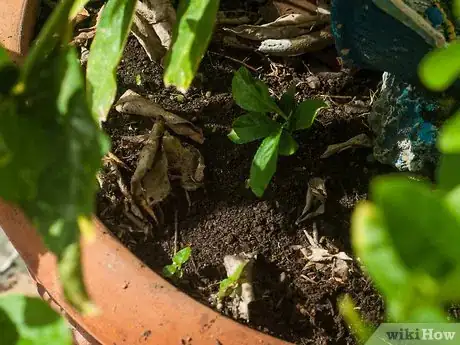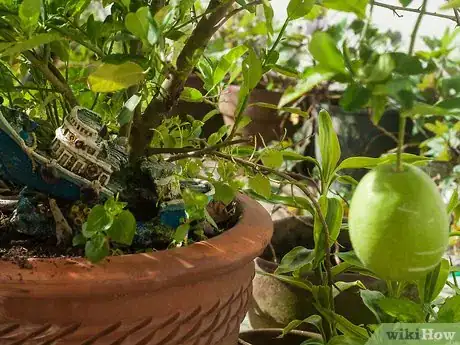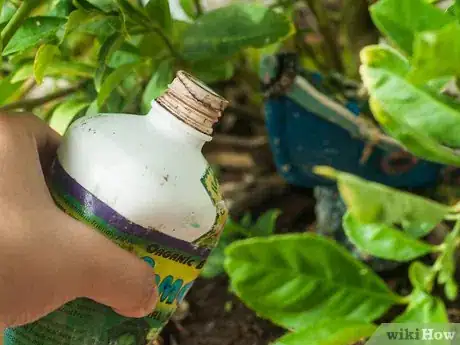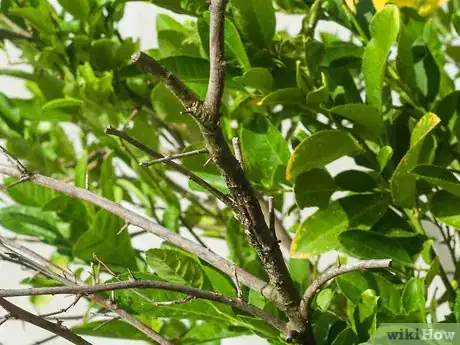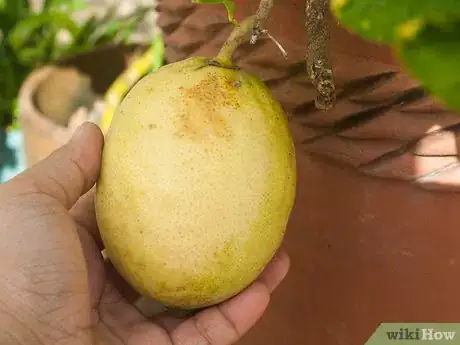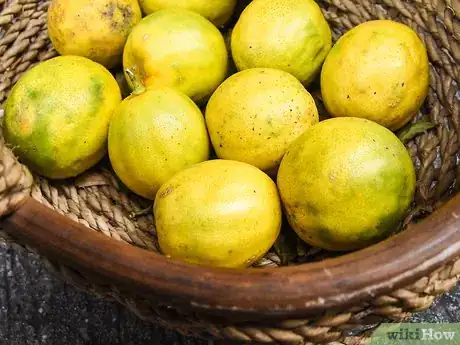This article was co-authored by Mark Leahy. Mark Leahy is a Plant Specialist based in the San Francisco Bay Area. He is the Co-Owner of Bella Fiora, a custom design floral studio, and SF Plants, a plant shop and nursery. Mark specializes in floral artistry and indoor plants including floral arrangements, terrace planters, office plantscapes, and living walls. Mark and his business partner have been featured in Vogue, The Knot, Today’s Bride, Wedding Wire, Modern Luxury, San Francisco Bride Magazine, San Francisco Fall Antique Show, Black Bride, Best of the Bay Area A-List, and Borrowed & Blue.
There are 12 references cited in this article, which can be found at the bottom of the page.
wikiHow marks an article as reader-approved once it receives enough positive feedback. In this case, 100% of readers who voted found the article helpful, earning it our reader-approved status.
This article has been viewed 221,992 times.
Lemons and other citrus plants ripen on the tree; once you pick a lemon, it will no longer ripen. If you purchase lemons from a supermarket, they should already be ripe and they may even last several weeks before going bad. If you picked an under-ripe lemon, you may have some success with leaving it in a bright location until it turns yellow, but you won't be able to make the lemon taste sweeter. This article will give you tips on what you can do to help your lemons ripen on your tree. It will also give you tips on what to look for when choosing lemons.
Steps
Ripening Lemons on the Counter
-
1Know that lemons will never truly ripen once you take them off the tree. They may turn more yellow and grow softer, but they will not necessarily become sweeter or juicier. If you get an under-ripe lemon and leave it on your counter, it may turn more yellow but it will still taste bitter.
-
2Try placing an under-ripe lemon in a bright location in your kitchen. The ideal place would be on your kitchen counter, away from direct sunlight. After a few days, the lemon will turn more yellow. Keep in mind, however, that this will not actually ripen the lemon on the inside; the lemon may still taste bitter and under-ripe even though it is yellow. It will, however, still work well as a garnish if you want to add some color to a dish or drink.Advertisement
-
3Understand that color is not a good indicator of ripeness. A greenish lemon does not necessarily mean that it is not yet ripe. You can still have a ripe lemon, even if it looks a little green.[1] This is because lemons ripen from the inside out. The flesh ripens first, then the skin. If you find yourself with an under-ripe lemon, try cutting it open anyway and tasting it. You could also follow the steps listed in this method for determining whether or not a lemon is ripe.
-
4Don't let an under-ripe lemon go to waste. Instead, consider using it to clean, or as an air fresher.
- You can make an effective rust and tarnish busting scrub by mixing salt and lemon juice into a paste.
- Add a few slices of lemon into a pot of simmering water. You can also add a few other fragrant herbs to compliment the lemon, such as rosemary.
Ripening Lemons on the Tree
-
1Know what your tree requires to be healthy and bear healthy fruit. Is your tree bearing fruit, but they are not ripening? Lemon trees need plenty of sunlight and lots of water. They also need to be pruned to allow for better air circulation. Without these, the fruit won't ripen. This section will give you some tips on how to get your tree's fruit to ripen. It will also tell you when you can expect the lemons to ripen.
-
2Be aware that lemons may take a while to ripen. Plan to pick lemons at least four months after the flowers bloom.[2] Some lemons may take up to nine months to ripen. Once a lemon is ripe, however, it can stay on the tree for several weeks.[3]
- Lemon trees need to mature before they can bear ripe fruit. Some lemon trees may bear fruit sooner, but the fruit won't be ripe. In general, lemon trees produce ripe fruit after they are three years old. If your tree is bearing fruit, but they never ripen, check the tree's age.
- Expect lemons to be ripe between late November and mid-January. Try to harvest your crop before mid-January, or you will risk hampering the following year's harvest.
-
3Make sure that the tree is planted in a warm, sunny location with direct sunlight. Not only does the tree need sunlight to grow, but the fruit need sunlight to turn yellow. If you are growing your tree indoors, consider keeping next to a window, ideally a south-facing one. Lemon trees need six to eight hours of sunlight each day.[4] Lemon trees also need warmth, and grow best when temperatures average at 70°F (21°C) during the day and 55°F (13°C) at night. Keep in mind that they will usually go into dormancy when temperatures fall below 55 F. (13 C.)[5]
-
4Make sure that the soil is well-drained. Lemon trees love water, but they do not like to stand in it. Make sure that the soil is well-drained. You can also plant the tree on a slight mount. This will prevent water logging.[6]
-
5Check the pH of the soil. If the lemons have been green for a long time, it could be a sign that the tree is not healthy. Check the pH using a pH testing kit, which you can purchase from your local nursery or gardening shop. Lemon trees need a soil that has a pH of 6.0 to 7.5.[7]
-
6Water the tree well, but allow the soil to dry before you water it again.[8] Plan on letting the first 4 to 6 inches (10.16 to 15.24 centimeters) of soil dry out first before you water the tree again. Avoid over-watering the tree, and do not let it sit in water. This could encourage rot, mold, and disease.[9]
- For the same reasons, do not mulch lemon (or any citrus) trees. Mulch will only hold moisture against the roots, increasing the probability of root rot. Most home citrus gardeners also keep the area under the drip line of the tree free of weeds and grass to promote better evaporation of any standing water.
-
7Feed the tree regularly with plant food. Choose a plant food made specifically for citrus trees, as it will have all the necessary nutrients. Lemon trees use up a lot of energy to grow and to produce leaves, flowers, and fruit. An under-nourished lemon tree won't have the energy to produce healthy fruit, which could prevent the tree from ripening.
- Lemon trees need a lot of nitrogen to grow. The fertilizer should contain more nitrogen than phosphorus or potassium.[10]
-
8Know that indoor trees also need to be pollinated. Lemon trees growing outside get pollinated by birds and insects. A tree growing in your home won't have that opportunity, and it may not produce ripe fruit, if any at all. To pollinate your indoor lemon tree, use a Q-tip to move pollen from one flower to the next one.
-
9Check for disease. If your tree's lemons just aren't ripening, you might want to check your tree for other signs of stress or disease. Check the tree for any signs of dead leaves or branches. Also, check the leaves for any signs of fungus or mold; they usually appear as black or white blotches. Another sign of disease is yellow blotches on the leaves.
Knowing When a Lemon is Ripe
-
1Try to pick a ripe lemon the first time around. Because lemons don't really ripen once they are picked, it's best to pick the right lemon from the start. This section will give you a few tips on what to look for when selecting lemons. Once you know what to look for, you will be less-likely to choose and be stuck with an under-ripe lemon.
-
2Look for a lemon that has a bright, yellow color. Keep in mind, however, that lemons ripen from the inside. This means that the lemon's skin will be the last part to ripen. You can still have a lemon that is ripe and juicy on the inside, and greenish on the outside.[11]
- Myer lemons will have a deeper yellow color; some might be more orange.
-
3
-
4Check the firmness. The ideal lemon should be firm, yet somewhat tender. A lemon that is too hard will be either under-ripe or shriveled inside.[14]
- Myer lemons have a thinner skin than regular lemons. They are ripe when they are soft. If you can push the skin of the lemon in more than ½ inch (1.27 centimeters) it may be over-ripe.[15]
-
5Look for lemons that have a smooth or glossy texture. Lemons that have too much of a bumpy texture will be under-ripe or not juicy enough. Another thing to look for is a waxy shine on the surface of the lemon.[16]
- Watch out for wrinkling. This is a sign your lemon is overripe.
-
6Know how to pick lemons off of trees. If you are harvesting lemons from a tree, you might want to put on a pair of gardening gloves; lemon trees often have thorns that can scratch you if you are not careful. Find a ripe fruit and grasp it in your hand. Gently twist it.[17] The lemon should come off easily If it doesn't come off easily, then it probably is not ripe yet.
-
7Taste the lemon to test whether or not it is truly ripe. If you are looking to harvest a bunch of lemons, but aren't sure whether or not they are ripe, you can always cut one in half and taste it. Most lemons will have a sour, but not bitter, taste to them. Meyer lemons, however, will be a little more sweet and less sour.
- Use a refractometer if you don’t want to test by taste, sight, or touch. Squeeze a drop of juice from the lemon onto the refractometer and look at the Brix scale. Pick lemons that have a sucrose level between 6 and 12, with 8 to 12 percent being the best.
Community Q&A
-
QuestionWill my lemons ever ripen here in Ireland? I have lots of green fruit.
 Community AnswerI went through an eternity with green lemons, I thought maybe I purchased lime trees that were mislabeled! I just picked my first ripened lemon and it took about 9 months from flower to ripened fruit.
Community AnswerI went through an eternity with green lemons, I thought maybe I purchased lime trees that were mislabeled! I just picked my first ripened lemon and it took about 9 months from flower to ripened fruit. -
QuestionI planted my Meyer lemon tree several months ago in southwest Florida. The tree has a main branch about 7' tall, and the lemons are not ripening but are starting to turn brownish. New, little lemons are forming. Should we remove all the old lemons and hope the next crop is better?
 Community AnswerIt could be the soil or clay underground, or exposure to the elements. Plant another one in a different spot and test which one has better lemons.
Community AnswerIt could be the soil or clay underground, or exposure to the elements. Plant another one in a different spot and test which one has better lemons. -
QuestionHow can I remove fungus from a lemon?
 Community AnswerTry spraying the tree with a mixture of 1 ounce dishwashing liquid (like Dawn) with 1 gallon of water, every 5 days.
Community AnswerTry spraying the tree with a mixture of 1 ounce dishwashing liquid (like Dawn) with 1 gallon of water, every 5 days.
References
- ↑ Gardening Know How, Lemons Not Turning Yellow
- ↑ Garden, Edible of the Month: Lemons and Limes
- ↑ Gardening Know How, Lemons Not Turning Yellow
- ↑ HGTV, Reviving a Fussy Meyer Lemon Tree
- ↑ Gardening Know How, Growing Lemons – How To Grow A Lemon Tree
- ↑ The Old Farmer's Almanac, Lemons & Oranges
- ↑ The Old Farmer's Almanac, pH Preferences
- ↑ HGTV, Reviving a Fussy Meyer Lemon Tree
- ↑ Thrifty Fun, Growing Lemons
- ↑ Thrifty Fun, Growing Lemons
- ↑ Gardening Know How, Harvesting Lemons
- ↑ Cook's Info, Lemons
- ↑ Gardening Know How, Harvesting Lemons
- ↑ Big Oven, Lemon
- ↑ Life Hacker, Is it Ripe? How to Tell when Your Favorite Fruits and Vegetables are Ready to Eat
- ↑ Four Winds Growers, Frequently Asked Questions: Care and Culture
- ↑ Gardening Know How, Harvesting Lemons
- ↑ Cook's Info, Lemons
About This Article
To ripen lemons on your counter top, it's first important to note that lemons will never truly continue to ripen once they are off the tree. Placing them in a bright location away from direct sunlight will turn the skin yellow and may make the lemon softer, which will be good for a garnish, but it will not ripen the inside, which may remain bitter and dry. Lemons ripen from the inside out, so color is not a good indicator of ripeness. A greenish lemon may be perfectly ripe on the inside. If you want to learn how to let a lemon ripen while it's still on the tree, keep reading the article!

